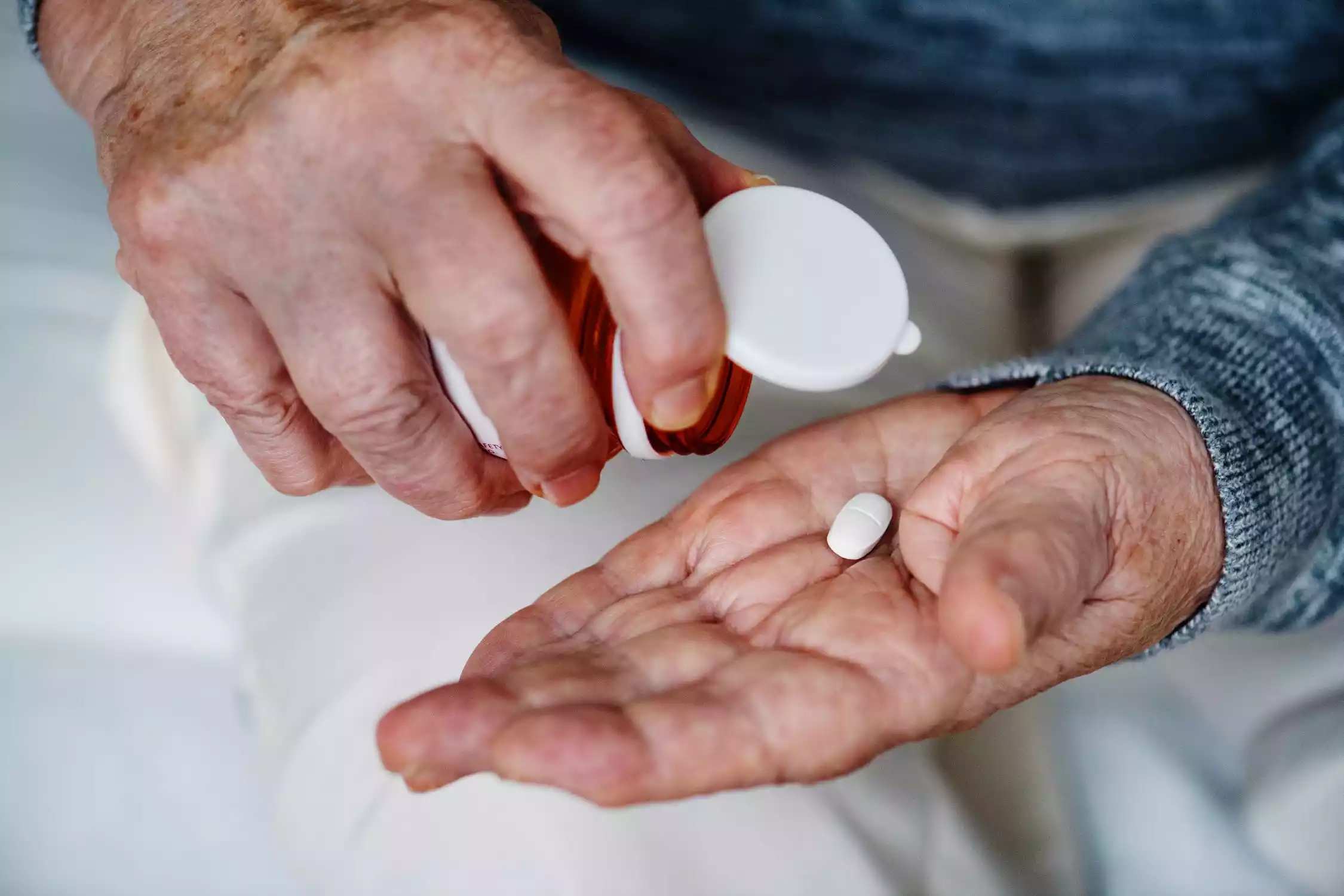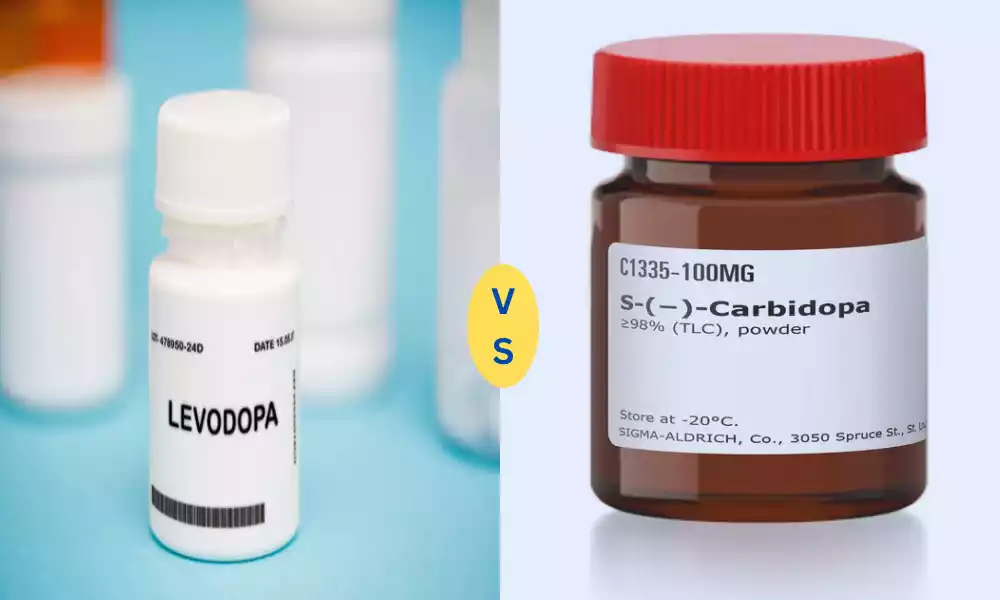Levodopa and Carbidopa are two vital medications used to treat Parkinson’s disease, a neurodegenerative disorder affecting movement control due to a lack of dopamine in the brain. Levodopa acts as a precursor to dopamine, replenishing its levels and alleviating motor symptoms. Carbidopa enhances Levodopa’s effects by preventing its premature conversion into dopamine outside the brain, resulting in more effective symptom relief. Together, these medications form a powerful combination that has revolutionized the management of Parkinson’s symptoms and improved patients’ quality of life.
What is Levodopa?

Levodopa, also known as L-DOPA, is a medication primarily used to treat Parkinson’s disease and dopamine-responsive dystonia. Parkinson’s disease is a neurodegenerative disorder that affects movement control, causing symptoms such as tremors, rigidity, and bradykinesia (slowness of movement). The condition is associated with a reduction in dopamine levels in the brain, a neurotransmitter essential for smooth, coordinated muscle movements.
Levodopa acts as a precursor to dopamine. Unlike dopamine, Levodopa can cross the blood-brain barrier, making it effective in supplementing the brain’s diminished dopamine levels. Once it crosses into the brain, Levodopa is converted into dopamine by the enzyme aromatic L-amino acid decarboxylase, commonly known as DOPA decarboxylase. This helps in alleviating the symptoms associated with low dopamine levels, such as those seen in Parkinson’s disease.
When administered alone, much of the Levodopa is converted into dopamine outside the brain, leading to various side effects and reducing its efficacy in treating Parkinson’s symptoms. This is why it is often administered in combination with another medication like Carbidopa, which prevents this peripheral conversion, ensuring that more Levodopa reaches the brain.
Origin and Chemical Structure
Origin
Levodopa was first synthesized in the 1930s but gained prominence in the 1960s as an effective treatment for Parkinson’s disease. Researchers found that it could cross the blood-brain barrier and replenish the diminishing levels of dopamine in the brain, thus relieving some of the symptoms of the disease.
Chemical Structure
Levodopa is an amino acid and its chemical formula is C9H11NO4. Structurally, it resembles the amino acids tyrosine and phenylalanine, which are building blocks of proteins. The similarity to these naturally occurring substances allows Levodopa to be effectively absorbed by the body and to cross the blood-brain barrier. Once inside the brain, it is converted into dopamine, facilitated by its chemical structure which is a direct precursor to this neurotransmitter.
How Does Levodopa Work?
- Precursor Role: Levodopa acts as a precursor to dopamine, serving as the “raw material” that can be converted into dopamine.
- Blood-Brain Barrier: Unlike dopamine, Levodopa is able to cross the blood-brain barrier, allowing it to enter the central nervous system.
- Enzymatic Conversion: Once in the brain, it is converted into dopamine by the enzyme DOPA decarboxylase (aromatic L-amino acid decarboxylase).
- Replenishes Dopamine: The converted dopamine then interacts with dopamine receptors in the brain, helping to relieve symptoms such as tremors and muscle stiffness associated with dopamine deficiency.
- Peripheral Conversion: Some Levodopa is also converted to dopamine outside of the brain, leading to side effects and reducing the amount that reaches the brain.
- Carbidopa Combo: Often administered with Carbidopa to inhibit peripheral conversion, ensuring that more Levodopa reaches the brain.
- Symptom Relief: Ultimately, the increase in dopamine levels in the brain alleviates symptoms of Parkinson’s disease and dopamine-responsive dystonia.
Each of these bullet points highlights a key aspect of how Levodopa functions to alleviate symptoms of conditions associated with dopamine deficiency, like Parkinson’s disease.
What is Carbidopa?

Carbidopa is a medication commonly used in combination with Levodopa for the treatment of Parkinson’s disease and dopamine-responsive dystonia. Unlike Levodopa, Carbidopa does not cross the blood-brain barrier, which means it doesn’t enter the brain and doesn’t directly affect levels of dopamine there. Its primary role is to inhibit the action of the enzyme aromatic L-amino acid decarboxylase (also known as DOPA decarboxylase) in peripheral tissues.
This enzyme is responsible for converting Levodopa into dopamine. By inhibiting this enzyme outside the brain, Carbidopa ensures that more Levodopa is available to cross the blood-brain barrier and get converted into dopamine within the brain, where it is needed to alleviate symptoms. This not only makes the treatment more effective but also allows for lower doses of Levodopa to be used, thereby reducing the risk of side effects like nausea and orthostatic hypotension, which can occur when dopamine is elevated outside the brain.
The combination of Levodopa and Carbidopa is often found in medications like Sinemet, where Carbidopa ensures that Levodopa’s effectiveness is maximized while its side effects are minimized. Overall, while Carbidopa doesn’t treat Parkinson’s or dopamine-responsive dystonia directly, it plays a critical role in making Levodopa therapy more effective and tolerable.
Origin and Chemical Structure
Origin
Carbidopa was developed as an adjunct therapy to Levodopa in the late 20th century. It was specifically designed to improve the effectiveness and reduce the side effects of Levodopa when treating conditions like Parkinson’s disease.
Chemical Structure
Carbidopa is an organic compound with the chemical formula C10H14N2O4. Its structure includes a hydrazine functional group, which is crucial for its enzymatic inhibitory activity. Unlike Levodopa, it doesn’t resemble amino acids closely and does not serve as a precursor for any neurotransmitters. Its unique chemical structure allows it to inhibit the enzyme that converts Levodopa to dopamine in peripheral tissues, without affecting the central nervous system directly.
How Does Carbidopa Work?
- Enzyme Inhibition: Carbidopa works by inhibiting the enzyme aromatic L-amino acid decarboxylase (also known as DOPA decarboxylase) in peripheral tissues outside the brain.
- Doesn’t Cross Blood-Brain Barrier: Carbidopa is unable to cross the blood-brain barrier, meaning its actions are limited to the peripheral tissues.
- Preservation of Levodopa: By inhibiting the enzyme that converts Levodopa to dopamine outside the brain, Carbidopa ensures that a greater proportion of Levodopa reaches the brain.
- Increased Effectiveness: This allows for more Levodopa to be converted to dopamine in the brain, making the treatment more effective at alleviating symptoms of Parkinson’s disease and dopamine-responsive dystonia.
- Lower Doses: The inhibition of peripheral conversion also allows for lower doses of Levodopa to be effective, reducing the risk of side effects.
- Reduced Side Effects: Carbidopa minimizes side effects such as nausea and orthostatic hypotension that can occur when too much Levodopa is converted to dopamine outside the brain.
- Combined Therapy: It is most commonly used in combination with Levodopa in medications like Sinemet to optimize the effectiveness and minimize the side effects of Parkinson’s disease treatment.
Carbidopa’s primary role is to make Levodopa treatment more effective and tolerable by ensuring that more of it reaches the brain where it is needed, and by reducing the peripheral side effects of Levodopa therapy.
Comparison Table of Levodopa and Carbidopa
Below is a comparison table that provides a side-by-side look at Levodopa and Carbidopa:
| Attribute | Levodopa | Carbidopa |
|---|---|---|
| Primary Function | Dopamine precursor for the brain | Inhibits peripheral conversion of Levodopa to dopamine |
| Ability to Cross BBB | Yes (Crosses the blood-brain barrier) | No (Does not cross the blood-brain barrier) |
| Role in Treatment | Alleviates Parkinson’s symptoms by increasing dopamine | Enhances Levodopa efficacy; reduces side effects |
| Side Effects | Nausea, orthostatic hypotension, dyskinesias | Generally well-tolerated; can have additive side effects when combined with Levodopa |
| Chemical Formula | C9H11NO4 | C10H14N2O4 |
| Direct Effect on Brain | Increases dopamine levels | No direct effect; works by preserving Levodopa |
| Typical Use | Used in combination with Carbidopa for better effect | Almost always used with Levodopa |
| Origin | Synthesized in the 1930s; used since the 1960s for Parkinson’s | Developed in the late 20th century as an adjunct to Levodopa |
This table offers a condensed overview of the distinctions between Levodopa and Carbidopa. While both are pivotal in the treatment of Parkinson’s disease, their roles, functions, and characteristics differ substantially. Combining them leverages their synergistic benefits.
Why are they Combined?
Levodopa and Carbidopa are combined for several critical reasons that enhance the effectiveness and tolerability of Parkinson’s disease treatment. Here’s why they are often administered together:
Maximize Effectiveness
- More Levodopa in the Brain: Carbidopa prevents the conversion of Levodopa to dopamine in peripheral tissues, ensuring that a larger amount of Levodopa reaches the brain where it’s needed.
- Increased Dopamine Levels: With more Levodopa reaching the brain and being converted to dopamine, symptoms like tremors, stiffness, and bradykinesia are more effectively managed.
Minimize Side Effects
- Reduced Peripheral Conversion: By inhibiting the conversion of Levodopa to dopamine outside the brain, Carbidopa reduces the risk of side effects like nausea and orthostatic hypotension.
- Lower Effective Dose: The Carbidopa component allows for lower doses of Levodopa to be used, further minimizing the risk of side effects from Levodopa.
Convenience and Compliance
- Simplified Dosing: Combining the two medications into a single tablet like Sinemet simplifies the dosing regimen, making it easier for patients to adhere to their medication schedule.
- Fine-Tuning Treatment: The combination allows for healthcare providers to easily adjust the ratio of Levodopa to Carbidopa, enabling a more tailored treatment approach.
Cost-Effectiveness
- Reduced Medication Burden: The combined therapy may require fewer overall medications, which can be more cost-effective for patients and healthcare systems.
- Efficient Monitoring: With both drugs in one tablet, it’s easier for healthcare providers to monitor the effects and side effects, streamlining the management of the disease.
Levodopa and Carbidopa are combined to enhance the effectiveness, reduce the side effects, and improve the practicality of treatment for Parkinson’s disease and other conditions involving dopamine deficiency. This combination results in a more efficient and tolerable therapy that benefits both patients and healthcare providers.
Benefits of the Combination
The combination of Levodopa and Carbidopa offers the following benefits in the treatment of Parkinson’s disease:
-
- Enhanced Efficacy: Carbidopa prevents the breakdown of Levodopa in the bloodstream, increasing its effectiveness in alleviating symptoms.
- Reduced Side Effects: Carbidopa minimizes nausea, vomiting, and motor fluctuations associated with Levodopa therapy.
- Lower Dosage: Carbidopa allows for lower Levodopa doses, reducing the risk of side effects and delaying tolerance development.
- Improved Convenience: The combination is available as a single formulation, simplifying dosing and enhancing patient adherence.
- Effective Symptom Relief: It targets key motor symptoms like tremors and bradykinesia, enhancing patients’ quality of life.
- Customized Treatment: Dosing flexibility enables tailored treatment to individual patient needs.
- Long-term Management: Provides sustained symptom relief, promoting patient independence over the long term.
- Neuroprotective Potential: Levodopa’s potential neuroprotective effects can be optimized with Carbidopa’s assistance.
Levodopa and Carbidopa together optimize treatment efficacy, minimize side effects, and improve overall quality of life for Parkinson’s patients.
Dosage and Administration

The dosage and administration of Levodopa/Carbidopa (Sinemet) can vary depending on the individual patient’s needs, the severity of Parkinson’s disease symptoms, and the specific formulation of the medication. It’s crucial to follow your healthcare provider’s instructions and the dosing recommendations provided with the medication.
Below is a general overview of dosage and administration guidelines:
1. Initial Dosing:
- Treatment typically begins with a low dose to minimize side effects.
- A common starting dose might be Levodopa 100 mg/Carbidopa 25 mg (Sinemet 100/25).
2. Titration:
- Dosing should be titrated based on the patient’s response to treatment and the severity of their symptoms.
- The dose is usually increased gradually, often at weekly intervals, until optimal symptom control is achieved.
3. Maintenance Dose:
- The maintenance dose is highly individualized and can vary widely.
- It may range from a few tablets per day to several tablets taken multiple times daily.
4. Combination Formulations:
- Levodopa and Carbidopa are often available in different combination ratios (e.g., 100/25, 200/50). The choice depends on the patient’s needs and the formulation prescribed.
5. Extended-Release Formulations:
- Extended-release (ER) formulations are also available, which provide a more sustained release of medication throughout the day.
- These formulations may be taken less frequently, typically 2 to 3 times daily.
6. Food Interaction:
- Levodopa absorption can be influenced by food. To improve absorption, it is often recommended to take Levodopa/Carbidopa on an empty stomach, but this should be discussed with a healthcare provider as individual responses can vary.
7. Timing and Consistency:
- It’s essential to take the medication at the same times each day to maintain a consistent level of Levodopa in the bloodstream.
- Missing doses can lead to fluctuations in symptom control.
8. Monitoring:
- Regular follow-up appointments with a healthcare provider are essential to assess treatment efficacy and adjust the medication as needed.
- They will monitor for any side effects or complications.
9. Additional Considerations:
- Dosage adjustments may be required if a patient experiences motor fluctuations, dyskinesia’s, or if their symptoms worsen over time.
- Patients should not abruptly stop taking Levodopa/Carbidopa, as this can lead to withdrawal symptoms or a worsening of Parkinson’s symptoms. Dose reductions should be done under medical supervision.
Always consult with a healthcare professional for specific dosing instructions and any concerns regarding Levodopa/Carbidopa therapy. Parkinson’s disease management is highly individualized, and medication regimens should be tailored to each patient’s unique needs and response to treatment.
Side Effects of Levodopa and Carbidopa
Side effects can vary depending on the individual, the dosage, and other medications the person may be taking. Here are some common and less common side effects for Levodopa and Carbidopa:
Levodopa
Common Side Effects
- Nausea: Often occurs especially when treatment is initiated.
- Orthostatic Hypotension: Dizziness or fainting when standing up quickly.
- Dyskinesias: Involuntary movements, especially with long-term use or high doses.
- Confusion or Hallucinations: Especially in older patients or those with a history of psychiatric conditions.
Less Common Side Effects
- Dry Mouth: Less frequently reported.
- Insomnia or Sleep Disturbances: Altered sleep patterns or difficulty in falling asleep.
Carbidopa
Carbidopa is generally well-tolerated but can contribute to side effects when combined with Levodopa, such as:
- Nausea: Although Carbidopa can actually reduce the nausea associated with Levodopa, it might still occur.
- Orthostatic Hypotension: Possible, especially when adjusting dosages.
- Dizziness or Headache: Can occur but is generally less common.
Combined Treatment
When Levodopa and Carbidopa are taken together, some side effects can be amplified, although Carbidopa generally helps in reducing the nausea and orthostatic hypotension associated with Levodopa treatment.
- Potential for Additive Side Effects: Such as confusion or hallucinations.
- Complex Motor Fluctuations: “On-Off” phenomena, where the medication seems to suddenly stop working and then start again, can occur with long-term use.
It’s essential to consult with a healthcare provider for a full list of potential side effects and to discuss any new or unusual symptoms. Monitoring and regular check-ups can help manage these side effects effectively.
Precautions and Interactions
Taking Levodopa and Carbidopa comes with specific precautions and potential interactions that should be closely monitored. Here are a few key points to keep in mind:
Precautions
- Medical History: It’s important to discuss your complete medical history with your healthcare provider, including any history of heart, liver, or kidney disease, as well as psychiatric conditions.
- Pregnancy and Breastfeeding: Consult your healthcare provider if you are pregnant, planning to become pregnant, or are breastfeeding.
- Sudden Withdrawal: Do not suddenly stop taking these medications without consulting a healthcare provider, as this can lead to severe symptoms.
- Motor Fluctuations: Long-term use can lead to a phenomenon known as “On-Off” symptoms, which should be promptly reported.
- Diet: High-protein meals can interfere with the absorption of these medications. Consult a healthcare professional for guidance regarding diet.
Interactions
- MAO Inhibitors: These drugs can interact dangerously with Levodopa and are generally contraindicated.
- Antipsychotic Medications: These can counteract the effects of Levodopa.
- Iron Supplements: May interfere with the absorption of Levodopa and Carbidopa.
- Other Medications: Other drugs for conditions like high blood pressure, arrhythmias, or depression may also interact with Levodopa and Carbidopa.
- Alcohol: May exacerbate some side effects like drowsiness or dizziness.
Always consult your healthcare provider for personalized advice, especially if you’re taking other medications or have other medical conditions. Regular monitoring is essential for optimizing treatment and minimizing risks.
Final Thoughts
Levodopa and Carbidopa are vital medications in the treatment of Parkinson’s disease and related conditions. While Levodopa acts as a precursor to dopamine, helping to alleviate symptoms, Carbidopa enhances its effectiveness and reduces side effects by preventing peripheral conversion of Levodopa to dopamine. When combined, they offer a more effective, well-tolerated, and convenient treatment option.
It’s crucial to follow healthcare provider guidelines for dosage, administration, and monitoring to optimize treatment and minimize potential side effects and interactions. Always consult with healthcare providers for tailored treatment plans.



